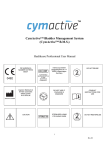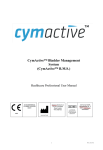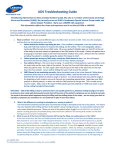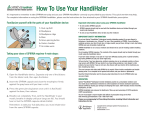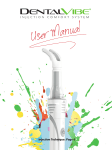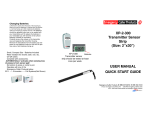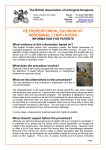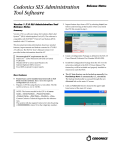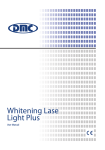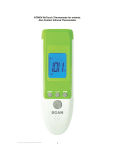Download our Patient IFU in PDF format
Transcript
CymActive™ Bladder Management System (CymActive™ B.M.S.) Patient User Manual mdi Europa GmbH Langenhagener Str. 71 30855 Langenhagen Germany DO NOT REUSE Ingenion Medical Ltd 64 New Cavendish Street London W1G 8TB UK DO NOT USE IF PACKAGE IS DAMAGED CONSULT INSTRUCTIONS FOR USE CAUTION STERILISED USING ETHYLENE OXIDE DO NOT RESTERILISE CE MARKING & NUMBER NOTIFIED BODY AUTHORIZED REPRESENTATIVE IN THE EUROPEAN COMMUNITY 0482 MANUFACTURER 1 Rev.02 1. Indications Indications for Use of the CymActive™ Bladder Management System: (CymActive™ B.M.S.). The CymActive™ B.M.S. is indicated for use for urinary drainage in adult men who require a device to manage bladder drainage for urinary retention. Contents 1. 1 CymActive™ Intra Urethral Catheter (CymActive™ I.U.C.) preassembled to CymActive™ Inserter. 2. 1 Healthcare Professional User Manual. 3. 1 Patient User Manual. Accessory (required but supplied separately): 1. The CymActive™ Actuator: The CymActive™ Actuator is an accessory and is required and intended only for use with the CymActive™ Bladder Management System. The correct handling is described in this instruction for use. The CymActive™ Actuator is a reusable non-sterile device. Contacting materials: The patient contacting material of the indwelling CymActive™ I.U.C. is silicone. The patient contacting material of the single use CymActive™ Inserter is PVC. 2 Rev.02 2. Product Overview CymActive™ I.U.C. CymActive™ Inserter Figure 1: CymActive™ Intra Urethral Catheter (CymActive™ I.U.C.) preassembled to CymActive™ Inserter. Extraction Tethers Coudé Tip UroValve™ inserted into Valve Cavity Malecot Figure 2: CymActive™ Intra Urethra Catheter (CymActive™ I.U.C.) with UroValve™ Figure 3: CymActive™ Actuator (supplied separately) 3 Rev.02 Contraindications, Warnings, Precautions, and Possible Adverse Events 3. Contraindications (Circumstances when it should not be used) This device contains metal. Therefore, a Patient must not have the CymActive™ Intra Urethral Catheter (CymActive™ I.U.C.) inside them when undergoing a magnetic resonance imaging (MRI) scan. A Patient who is required to keep their bladder empty by constant free drainage should not use the CymActive™ I.U.C. A Patient with a medical implant that could be affected by exposure to a magnet, such as any implanted electromechanical device that the magnet may interfere with, such as implanted pulse generators, should NOT use the CymActive™ I.U.C. Check with your doctor before using this device if you think you may have a medical implant that could be affected. Patients with documented history of sensitivity to silicone should not use the CymActive™ I.U.C. A Patient with an estimated length of the urethra (from bladder neck to halfway down the penile urethra) which is greater than 160mm should not use the CymActive™ I.U.C. This must be determined by the urologist or healthcare professional responsible for inserting the device. 4. Warnings (Things men using the CymActive™ B.M.S. should be aware of) Patients who are unable to understand the instructions for use, or operate the CymActive™ B.M.S. themselves and do not have a full-time companion or caretaker who the patient is willing to let operate the device and who is willing and able to follow the Instructions for Use and assist the Patient (e.g. open the UroValve™ using the CymActive™ Actuator) should not use the CymActive™ I.U.C. Patients who have current signs, symptoms and/or laboratory confirmation of urinary tract infection should have this treated and resolved before insertion. Patients who have a current diagnosis of bladder stones, symptomatic renal or urethral calculus should not use the CymActive™ I.U.C. Patients with a history of bladder surgery within the past two months should not use the CymActive™ I.U.C. Patients with a history of previous prostatic or urethral surgery should speak to their doctor about this before using the CymActive™ I.U.C. as it may not stay in the proper place after insertion. 4 Rev.02 The CymActive™ I.U.C. should be removed by a Healthcare Professional prior to the thirty-first (31st) day of use. The CymActive™ I.U.C. has not been adequately evaluated for use in patients who have a spinal cord injury. This device may not stay in the proper position in patients with spinal cord injury. A patient with urinary retention due to a spinal cord injury should only use the CymActive™ I.U.C. after discussing with their urologist. This device should only be used in a patient with spinal cord injury below T6 who has a good perianal reflex as determined by the physician. Patients with spinal cord injury and a documented history of autonomic dysreflexia should not use the CymActive™ I.U.C. The CymActive™ I.U.C. has not been studied in adolescents or children. Use in adolescents or children is not recommended. 5. Precautions (Checks that should be done before use of the CymActive™ B.M.S. / CymActive™ I.U.C.) A Healthcare Professional should examine packaging, verifying its integrity, to ensure sterility of the device has not been compromised. If packaging is damaged, do not use the CymActive™ I.U.C. The CymActive™ I.U.C. shall not be re-sterilized by the customer. Insertion and removal of the CymActive™ I.U.C. is intended to be performed by healthcare professionals. The CymActive™ I.U.C. should be handled only under aseptic conditions prior to and during insertion. If Patient has been advised to use prophylactic antibiotics during invasive procedures, the Healthcare Professional will judge the potential risk of using the CymActive™ I.U.C. and judge the need for antibiotic prophylaxis on insertion. The CymActive™ I.U.C. should only be used by men who have adequate bladder capacity. The Healthcare Professional must review with the Patient the instructions listed in section 7.1. The CymActive™ Actuator should be carried with the patient at all times. In case you have lost the CymActive™ Actuator please consult your Healthcare Professional or doctor. 5 Rev.02 6. Possible Adverse Events (Things that may go wrong and that you should look out for when fitted with the CymActive™ B.M.S.) Possible harm associated with the use of the CymActive™ B.M.S. may include urinary tract infection, damage (trauma) to the urethra or meatus, blood in the urine, stricture development, pain in the bladder, abdomen, or urethra, urine leakage, catheter or valve blockage, catheter migration, difficulty in removing the CymActive™ I.U.C. or the strings may snap upon attempted extraction. In the unlikely case of any adverse events you should immediately consult the Healthcare Professional. If you feel pain or discomfort in your bladder, abdomen, or urethra, you should contact your doctor. If you have to keep opening the UroValve™ many times in a short period of time (for example, more than once every two hours) because you feel that you have to pass your urine urgently, then you should contact your doctor. If excessive urine leakage occurs after removing the CymActive™ Actuator to allow the UroValve™ to close, try to open and close the UroValve™ several times by moving the Actuator magnet under the shaft of the penis near the scrotum; moving the Actuator magnet slightly left, right, up, down, or in and out; and then removing the Actuator. After several attempts, if excessive urine leakage continues, please contact a physician in a timely manner. If reduced or no urine flows when trying to empty the bladder, try to open and close the UroValve™ several times by moving the Actuator magnet under the shaft of the penis near the scrotum; moving the Actuator magnet slightly left, right, up, down, or in and out; and then removing the Actuator. After several attempts, if urine still does not flow or flows at a reduced rate, please contact a physician immediately. 6 Rev.02 7. Summary of Instructions for Use The CymActive™ Bladder Management System (CymActive™ B.M.S.). Instructions for Use for Patients. Insertion and removal of the CymActive™ Intra Urethral Catheter (CymActive™ I.U.C.) is intended to be performed by a Healthcare Professional only. You should practice using the CymActive™ Actuator magnet in the doctor’s office after the CymActive™ I.U.C. is inserted to make sure you can do it well. If you need assistance, the person providing the assistance (your companion or caretaker) should practice using the CymActive™ Actuator magnet to make sure they know how to help you empty your bladder before leaving the doctor’s office. Care should be taken to ensure that each Patient is able to actuate the UroValve™ properly and without assistance (if companion or healthcare aide is not used) as shown by one successful demonstration prior to leaving the clinic. a. Position yourself as you would do if you have to pass urine. b. Remove the CymActive™ Actuator magnet from its pouch and hold it in the hand you write with. Grasp the shaft of your penis in the other hand. c. To empty your bladder: i. Move the CymActive™ Actuator magnet under the shaft of the penis near the scrotum to open the UroValve™. You should be able to pass urine. Forcefully pressing the CymActive ™ Actuator magnet against the body is not necessary to open the UroValve™, and may block the flow of urine through the urethra. 7 Rev.02 CymActive™ Actuator Figure 4: CymActive™ Actuator ii. In the event of reduced or no urine flow, try to open and close the UroValve™ several times by moving the CymActive™ Actuator magnet under the shaft of the penis near the scrotum; moving the Actuator magnet slightly left, right, up, down, or in and out; and then moving the Actuator away from the area. After several attempts, if urine still does not flow or flows at a reduced rate, you should contact your doctor immediately. iii. When the flow of urine stops, move the CymActive™ Actuator magnet away to close the UroValve™. Move the Actuator magnet back into position to open the UroValve™ again to see if you can pass any more urine. Try this several times until you feel that you have emptied your bladder completely. iv. In the event excessive urine leakage occurs after you have removed the CymActive™ Actuator to allow the valve to close, try to open and close the UroValve™ several times by moving the Actuator magnet under the shaft of the penis near the scrotum; moving the Actuator magnet slightly left, right, up, down, or in and out; and then removing the Actuator. After several attempts, if excessive urine leakage continues, contact a physician in a timely manner. v. Replace the CymActive™ Actuator magnet in the pouch. vi. Do not bring the CymActive™ Actuator magnet near to a computer, watch or credit card as it is a very strong magnet and could cause damage. vii. The CymActive™ I.U.C. should be removed by a Health Care Professional prior to the thirty-first (31st) day of use. 8 Rev.02 viii. If instructed to have a Magnetic Resonance Imaging (MRI) Scan, you must tell the doctors looking after you that you have a CymActive™ I.U.C. in your urethra. The CymActive™ I.U.C. must be removed before the MRI Scan because it contains metal. 7.1 The following should be discussed with your Healthcare Professional: (Further matters that you may wish to discuss with your doctor or nurse before having the CymActive™ I.U.C. inserted.) a) The CymActive™ I.U.C. has not been adequately evaluated concerning sexual intercourse during the period the device is in the body. It is not known what effect sexual activity will have on the function and positioning of the CymActive™ I.U.C. b) Actuate the CymActive™ I.U.C. at least every 4-6 hours or when you have the urge to do so. c) Fully empty your bladder during each actuation. d) You may initially experience a feeling of urgency, similar to what is described in the literature for indwelling catheters. The use of anticholinergic pharmaceuticals might be recommended. e) Keep the CymActive™ Actuator, even when shielded, away from objects that might be affected by a magnetic field, such as credit cards, computer screens, watches, etc. f) The CymActive™ Actuator is required for use, but is supplied separately. g) The CymActive™ Actuator should be carried with the patient at all times. In case you have lost the CymActive™ Actuator please consult your Healthcare Professional or doctor immediately. 9 Rev.02 © Ingenion Medical Limited 2014 10 Rev.02










